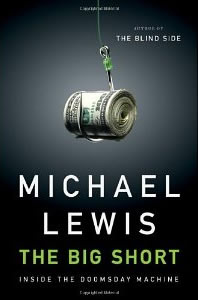Book Notes
 Michael Lewis, The Big Short; Inside the Doomsday Machine (New York: W.W. Norton, 2010), 266pp.
Michael Lewis, The Big Short; Inside the Doomsday Machine (New York: W.W. Norton, 2010), 266pp.
In October of 2008 my eighty-six-year-old father-in-law opened his monthly financial statement and was shocked to see that in the last month his Lehman Brothers stock had plummeted from $16,000 to $12. By that time, Lehman was not alone. Catastrophe had been brewing for a long time, and signs of the apocalypse were beginning to appear. In the third quarter of 2007, for example, Merrill Lynch reported that its potential exposure to certain subprime investments was $15.2 billion; one quarter later they tripled that estimate to $46 billion.
I still don't understand interest rate swaps, mezzanine collateralized debt obligations, or credit default swaps. But after reading Michael Lewis's best seller about the meltdown of the financial system, I don't feel so bad about my ignorance. "No ordinary human being," he writes, "had ever heard of these credit default swaps or, if the people behind them had their way, ever would. By design they were arcane, opaque, illiquid, and thus conveniently difficult for anyone except their creators to price" (201). Because of deliberate non-disclosure, accounting fraud, and hiding risk in complexity, "hardly anyone could understand a subprime mortgage-backed collateral debt obligation" (155) — not the clueless ratings agencies Moody's and S&P, not the hapless SEC, not investors, not Ben Bernanke, and not (to take only one example) Bank of America CEO Ken Lewis.
Credit default swaps fed upon the subprime mortgage boom, which made it possible for a Las Vegas stripper to own five investment properties, or for a strawberry picker with an income of $14,000 a year to buy a $724,000 house (97). These mortgages to people "one broken refrigerator from default" (169), many of which required no proof of employment, income, or money down, were designed to fail, so that the borrowers were forced to re-finance with an even riskier loan. Subprime mortgages with floating rates eventually comprised about 80% of mortgages. In an "originate and sell" strategy, the mortgages were then sold down the line, bundled as "investments," given high ratings by Moody's and S&P, and then ping-ponged between institutional buyers and sellers who gambled on them.
It wasn't exactly true that no one knew what was going on. The main focus of Lewis's book is on the very small number of people who did understand the idiocy and gross dishonesty of Goldman Sachs, Citigroup, Morgan Stanley and their kin, and who, based upon their understanding, "made a straightforward bet against the entire multi-trillion-dollar subprime mortgage market and, by extension, the global financial system" (105). These colorful contrarians never lost sight of a basic truth, that someone would eventually have to pay when the stripper and the strawberry picker inevitably defaulted on their loans. For these clear-sighted people who swam against very strong currents, it was like "buying cheap fire insurance on a house engulfed in flames" (164). In the end, we the tax payers paid for those bad loans and bailed out Wall Street and their executives who still "earned" tens of millions for their "work." My father-in-law never got his money back.


